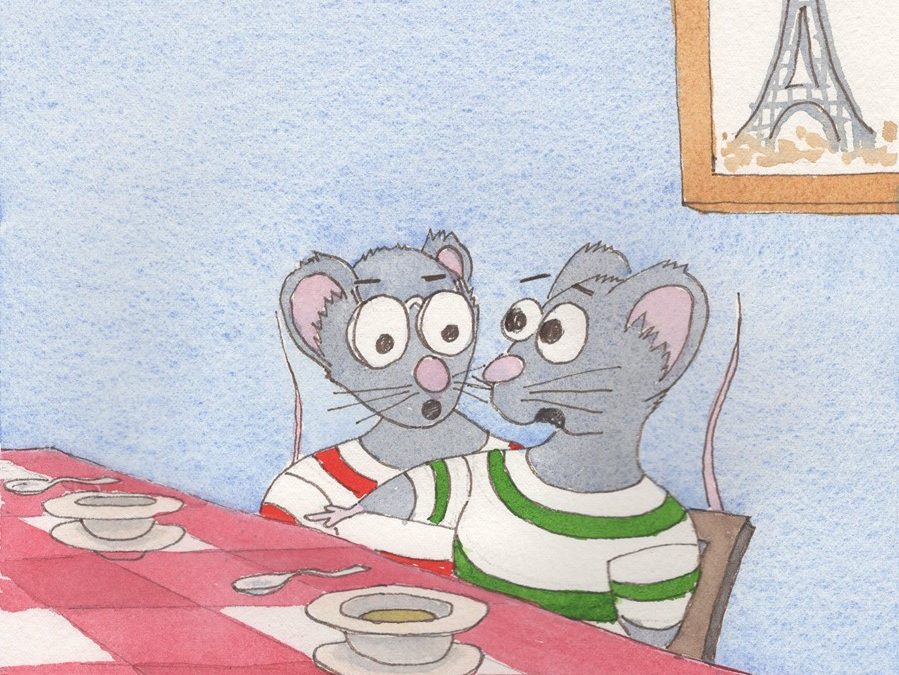
by DonnaGibbs | Oct 30, 2017 | Books and Children
Breaking the rules
Everyone who is a blogger advises you need to ‘blog’ at least twice a week. I haven’t managed anything like that and there has been an especially long gap since I last wrote. But now I really want to tell you about my new book, so here I am again.
When the Cat’s Away, a picture book for young children, illustrated by Lionel King, was launched on September 25th, 2017.
The launch, which some of you attended, was held at Stanton Library, North Sydney. John McCallum was our impressive MC and Ursula Dubosarsky graciously agreed to send our book out into the world. You can read her speech at the launch here. (Ursula’s kind words will long be cherished by me)
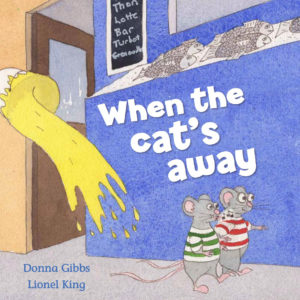
My just-turned one year old grandson, Noah, to whom I dedicated the book (Lionel dedicated it to Judy King, his wife) managed to upstage me as I delivered my speech. You can see him demonstrating his new skills of walking and clapping for the audience.
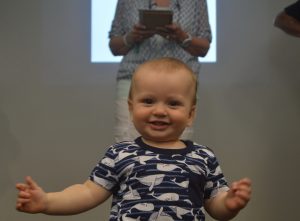
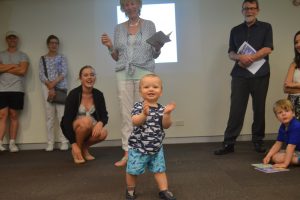
After the speeches, we had the trumpeter, Mark Strykowski, play the Marseillaise to get people in the mood for the storytelling. I was able to read the story from the online version projected onto the wall in the Conference Room at the library.
The process of creating this book was pure delight from my perspective. Once the text was written it was a matter of waiting for a new illustration to appear in my inbox, usually on a Sunday evening. Lionel is a scientist at RESMED and the weekends are when he does most of his sketching and painting. Numerous conversations followed as we adjusted both text and image until at last our book was ready to go into production.

It is such a pleasure for us to hear about children’s responses to the book. Already we’ve had quite a few comments such as “My daughter (3) woke this morning talking about mice in the house! “. We have also had some wonderful reviews – you can see them on Amazon and at Good Reads (you can ask questions about the book on this site as well) or look at them here. We are keen for more reviewers (only honest reviews) and if you, or someone you know, would like a review copy, please let me know.
“. We have also had some wonderful reviews – you can see them on Amazon and at Good Reads (you can ask questions about the book on this site as well) or look at them here. We are keen for more reviewers (only honest reviews) and if you, or someone you know, would like a review copy, please let me know.
So… if you would like to put the book in someone’s christmas stocking, it is available as a print book from places such as the Book Depository in the U.K, Amazon and the Moshshop. Or you can contact me on my website (donnagibbsbooks.com), or by email (gibbs.donna@gmail.com) and I can post it to you. It is also available as an ebook from Amazon and Smashwords for around $3.00.
In my next blog I’d like to talk about some books that are thought to send the wrong message to children. I’ll be interested to hear what you think.
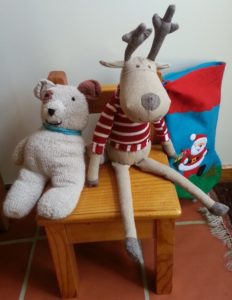
by DonnaGibbs | Dec 20, 2016 | Books and Children
Christmas greetings to you all. 
The characters in my christmas card are Sad the Dog (from Sandy Fussell’s Sad the Dog) and Reindeer (from Ursula Dubosarsky’s Reindeer’s Christmas Surprise). Both books are very popular with young children.
Have you heard of the Icelandic tradition of giving books on christmas eve? Thanks, Robyn, for telling me about this.
Meanwhile, hope you and your families have some book-filled holidays coming up and plenty of time to read.
Talk to you all next year!
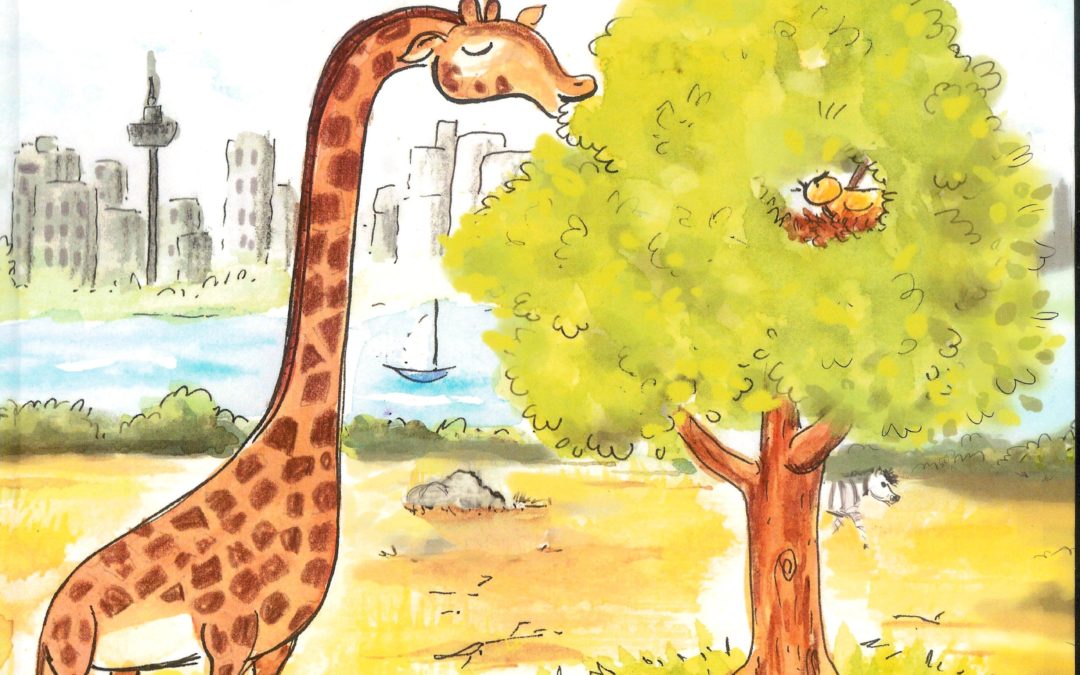
by DonnaGibbs | Oct 24, 2016 | Books and Children
Who’s afraid of graphic novels?
If yo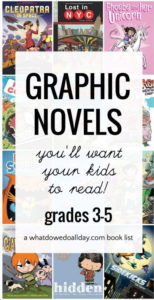 u have been hesitant about encouraging children to read graphic novels, it may be time to change your mind. On the Playful Learning website you can read about why graphic novels make great reading and learning
u have been hesitant about encouraging children to read graphic novels, it may be time to change your mind. On the Playful Learning website you can read about why graphic novels make great reading and learning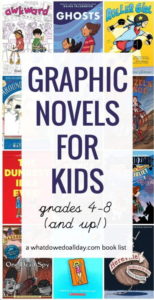 experiences for children.The article ‘5 great reasons to Read Graphic Novels’ is followed by a list of favourites that have proved their worth.
experiences for children.The article ‘5 great reasons to Read Graphic Novels’ is followed by a list of favourites that have proved their worth.
The author ends the article by saying: ‘If you are looking for even more inspiration the list on the A Mighty Girl website . . . is focused more on female characters, but there is no reason why boys won’t enjoy them just as much!’ (She must have read my last blog post, don’t you think?)
And if you are looking for even more titles, the website for What do we do all day offers lists of books to read, including lists of graphic novels.
From page to screen is another option worth pursuing. Thanks to Dr Kerry-Ann O’Sullivan for kindly forwarding this link about a series of graphic novels, The Hildafolk Collection by Luke Pearson. Netflix is planning a twelve-episode animated series, based on the first four books, for early 2018.
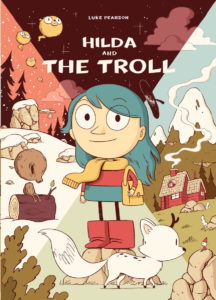
My new book
Bear Wants to Know, a picture book for 2 to 5s, is now available. I first wrote a version of this book for my granddaughter, Harriet, nearly a decade ago.
 Now with the help of illustrator, Janet Trotta, the story has evolved into a picture book. At first reading to my kindy group, the children were very taken with the last double page spread of the book (it was
Now with the help of illustrator, Janet Trotta, the story has evolved into a picture book. At first reading to my kindy group, the children were very taken with the last double page spread of the book (it was 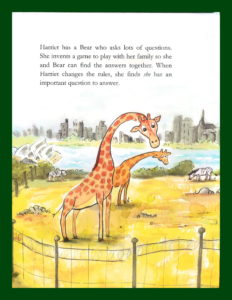 entirely Janet’s idea to do the page this way – so I am grateful to her). They liked pointing out to me all the things in Harriet’s bedroom that they’d seen during the story.
entirely Janet’s idea to do the page this way – so I am grateful to her). They liked pointing out to me all the things in Harriet’s bedroom that they’d seen during the story.
If you would like a copy of the book ($14.95 with free postage), or any of my other books, do email me (gibbs.donna@gmail.com) so I can arrange delivery.
The Fan Brothers
I read an interview recently about the illustrator brothers, Eric and Terry Fan – whom I’d not come across before. Their illustrations for The Night Garden, which they also co-authored, had me immediately intrigued.
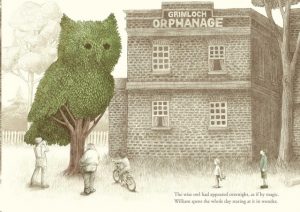
From The Night Garden
When visiting the Blues Point Bookshop (once you are inside it is very hard to leave), I came across The Darkest Dark illustrated by the Fan brothers and written by the astronaut Chris Hadfield. I think this book would have appeal for most age groups but particularly the 5 to 7 year olds. It is about overcoming fear of the dark but also about dreaming dreams and making them happen.

The book also has nostalgic appeal for adults because the child narrator huddles with others around a television, to watch Neil Armstrong step onto the surface of the moon. Some of my readers watched this event with me along with lots of school children, many moons ago when we were all crowded into a hall in Hinemoa.
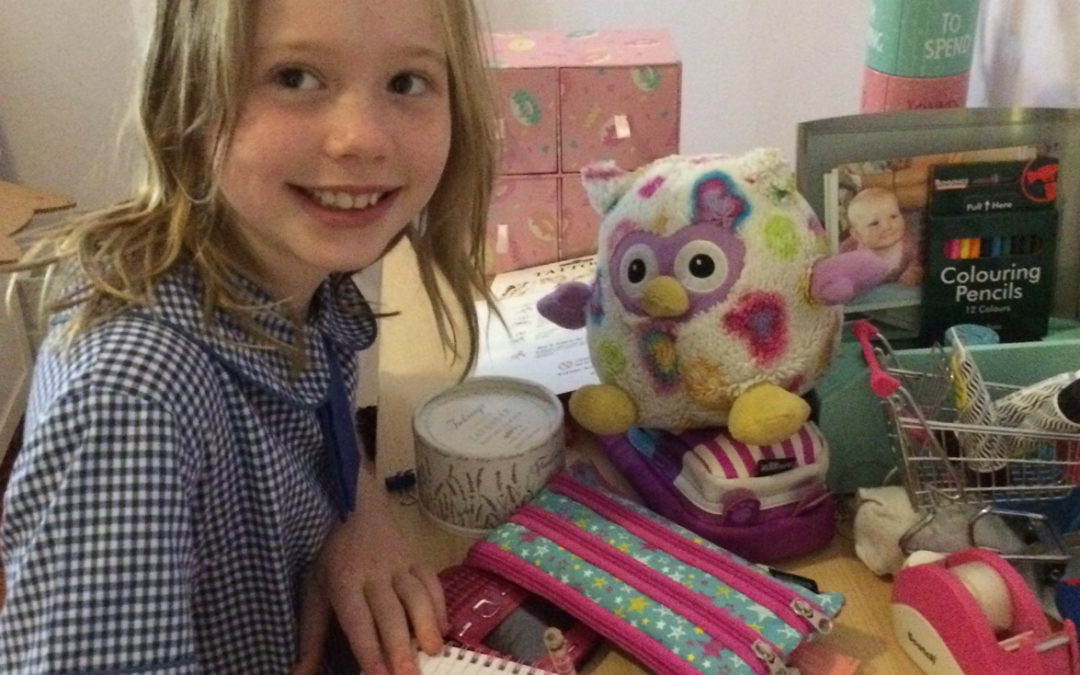
by DonnaGibbs | Aug 30, 2016 | Books and Children
Let me introduce three upper primary students who have plenty to say about what they like reading.

RUBY aged 10 in Year 4

MAX aged 11 in Year 6
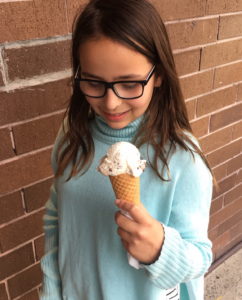
SASKIA aged 11 in Year 6
Did you have books read to you when you were little? Can you remember anything about that?
Max: Yes. I remember books about teddy bears, Winnie the Pooh, The Enchanted Woods, robot books.
Ruby: Ruby Flew Too. It was about a duck.
Saskia: Yes. We’re Going on a Bearhunt. And a lot of Dr Seuss.
Did you have any favourite picture books? Any you hated?
Max: My favourite picture book was called The Floods – about an abnormal family. For older kids they had chapter books. I also liked a big book about World War 1 and the Top 10 Battles that changed the world. I didn’t hate any.
Ruby: I didn’t like a book called Ruby about a car. I didn’t like it because it had pictures but I didn’t understand the words.
Saskia: I loved the Fancy Nancy series.
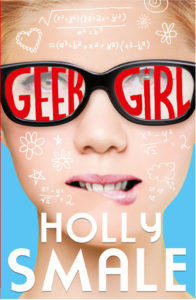 If your parents said you were going to live on a desert island or in space and you could only take one book, what would it be? Any reason for your choice?
If your parents said you were going to live on a desert island or in space and you could only take one book, what would it be? Any reason for your choice?
Max: If it was a desert island I would take a survival guide.
Ruby: A very very very thick book like Harry Potter!
Saskia: Either Geek Girl or Girl Online.
What kind of books do you like most now (eg factual information, animal stories, comics, narratives with female or male heroes, etc)?
Max: Narrative fiction. I find them engaging and they tell great stories with adventurous heroes that bend my imagination to make the world appear better.
Ruby: I like books with a twist, but a good twist that builds up so much tension.
Saskia: I love fiction or chapter books.
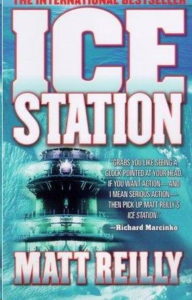 Can you suggest a book or an author for other children around your age to read?
Can you suggest a book or an author for other children around your age to read?
Max: Ice Station by Matthew Reilly. A gripping, fast paced military story.
Ruby: Emma Carroll The Girl Who Walked on Air. It’s really fun to read and once you start reading you don’t want to stop.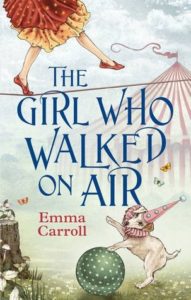
Saskia: The Hunger Games series by Suzanne Collins. It has so many twists and keeps you wanting more.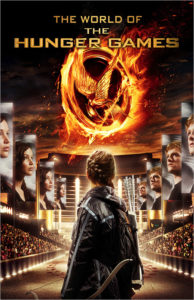
If you could write a book for children your age what would you make it about?
Max: A fantasy world based in an arctic universe where the heroes battle against the cold, frostbite, hypothermia, wolves and other problems beneath the snow, hidden in the blizzards.
Ruby: I would set it in reality. A book about a girl who runs away and she has to live through blizzards and things. She meets a wolf who follows her around and in the end they become friends and lie down together.
Saskia: My book would be set in reality and about a girl who is 12-13 but her life is very dramatic. Like everything goes wrong in her life!
Thanks Ruby, Max and Saskia for being guests on my blog. I’m working on a new book right now. it’s going to be part fantasy, part realism – set in an arctic universe with wolves, blizzards etc, and told from the point of view of a 12 to 13 year old for whom everything goes wrong. I’m guessing it’ll be a best seller!
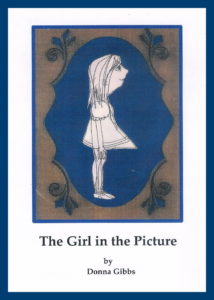
by DonnaGibbs | Aug 17, 2016 | Books and Children
An article in Daily Life, ‘How I’ve helped teach boys that girls are boring and unimportant’, by Kasey Edwards really made me think.
She quotes L.J. Lacey of the Melbourne children’s bookstore, Three Four Knock On The Door, saying that 90 per cent of the books she sells have a male protagonist, and customers almost never buy books for boys with a female main character. In contrast, she says, people buy books for girls with male protagonists all the time.
Edwards argues that when boys only read stories about boys or men, they’re given the implicit message that stories focusing on people who are different and whose experiences are different from their own are not worth bothering about.
She confesses that in the past when looking for a book for a boy she is as guilty as other adults of only buying books with male protagonists. It has never even occurred to her to buy a boy a book about a girl. She plans to change her habits because she believes it matters a lot in many important ways. You can read her article here.
I too must confess I tend to choose books for boys with male heroes. Two of my books have girls as main characters – The Girl in the Picture and The Girl in the App. I have never thought of giving these books to a boy to read or imagined them being bought for a boy.
 Recently I sent a few of my books including these to a friend for her children, a girl aged 10 and a boy aged 11. I imagined she’d give these two books to her daughter, but a message came back that she was reading them with her son. Some good parenting going on there!
Recently I sent a few of my books including these to a friend for her children, a girl aged 10 and a boy aged 11. I imagined she’d give these two books to her daughter, but a message came back that she was reading them with her son. Some good parenting going on there!
What are your book buying habits in relation to girls and boys? Any thoughts?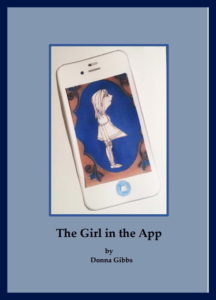
Footnote: I didn’t get any comments back about how you interpreted the cover of The Lost Thing so I’ve added a few things that I noticed.
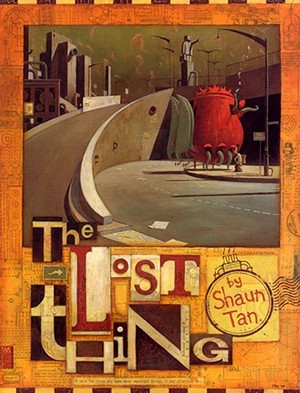 The printed title. Letters of uneven sizes and in a mixture of upper and lower case with the almost childish printing of the author’s name give the title a friendly, unconventional feeling. The word Lost stands out a bit because of its rich deep reddish colour. This suggests lostness is likely to be the focus of the story.
The printed title. Letters of uneven sizes and in a mixture of upper and lower case with the almost childish printing of the author’s name give the title a friendly, unconventional feeling. The word Lost stands out a bit because of its rich deep reddish colour. This suggests lostness is likely to be the focus of the story.
The main framed picture. This is a picture of a fairly ordered, yet empty type of city made of a lot of unappealing concrete. Is there an echo of the Jeffrey Smart picture of The Cahill Expressway in this?
There are hints in some of the buildings on the left that the city operates like clockwork. The statue could imply the city sees itself as rather important. There could be an echo of the Statue of Liberty in the outstretched arm? Is that undercut by the figure of the statue holding what looks like a briefcase and having a box like head?
The large red out of place object that has tentacles for legs is intriguing. It seems to be moving and alive or at least in working order. Are those surfboard like things wings for it to fly? Its incongruity with the rest of the scene makes you wonder about the part this thing will play in the story.
The only human figure is bent and odd looking – a bit like a distorted version of an office worker from one of John Brack’s famous cityscapes. Yet he hasn’t been quite swallowed up by conformity as Brack’s office workers have. This figure is still curious. He is drawn to look at and think about the strange misplaced thing he sees in front of him. A sign of hope perhaps?
The framing of the image and title. Marks around the main image are very ordered though faint. There are numbers, mechanical diagrams, rectangular blocks of colour, words and sentences of different lengths and in various fonts, all given varying degrees of importance. A message given some prominence (‘A tale for those who have more important things to pay attention to’) tells of an author whose humour is gentle and who is at home with irony. A large mark next to Shaun Tan’s name looks like a postmark. It makes me feel the book is on its way to me, a message from the author. I want to open the book to see how the story unfolds.

by DonnaGibbs | Jul 30, 2016 | Books and Children
Two books my Kindy class have enjoyed recently are:
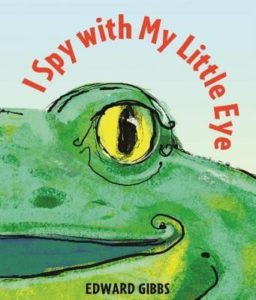 I Spy with my little Eye by Edward Gibbs. This book gives children the chance to guess which animal is on the other side of the spyglass. They get a hint because they can see part of it. It doesn’t seem to matter when they know the answers – they just love the repetition and the chance to call out the answer again and again. A good little twist in the ending as well.
I Spy with my little Eye by Edward Gibbs. This book gives children the chance to guess which animal is on the other side of the spyglass. They get a hint because they can see part of it. It doesn’t seem to matter when they know the answers – they just love the repetition and the chance to call out the answer again and again. A good little twist in the ending as well.
No, David by David Shannon was also a success. You can always tell when you are asked to read it again the moment you finish. The text is very simple and mainly a variation on the title. It took a while for the children to grasp that the pictures show David doing unacceptable things such as making sculptures from his food or making way too much noise. But by the time we got to David running down the street with no clothes after his bath (a deliciously funny back view), they were all conspirators with David and enjoying his unsociable behaviour. I couldn’t help thinking how amazing it is that we turn these tiny naked-when-born human beings into three and four year olds who all think the sight a boy without clothes running away from his cross mother is a great joke. You can watch the video of this story here. 
If you are looking for picture books that suit all ages you can’t go past the work of Jeannie Baker or Shaun Tan. I suspect a child needs to be around 5 before they are likely to enjoy these books (please tell me if I’m wrong) but their insights and way of telling bring immense pleasure to many different age groups. You don’t need the excuse of having a child to read them to – as with many picture books you can read them for your own pleasure.
 Jeannie Baker’s Circle, for example, is about the wonder of the bartailed godwit’s journey from Alaska to Australia and New Zealand – the longest unbroken migration of any bird. Baker visited many of the locations along the way such as Alaska and China to select fabric, sand, vegetation and other unique materials to use in her beautiful mixed media collages. The book gently, yet compellingly, demonstrates how treatment of our own environment has far reaching effects on the lives of other living things both near and far.
Jeannie Baker’s Circle, for example, is about the wonder of the bartailed godwit’s journey from Alaska to Australia and New Zealand – the longest unbroken migration of any bird. Baker visited many of the locations along the way such as Alaska and China to select fabric, sand, vegetation and other unique materials to use in her beautiful mixed media collages. The book gently, yet compellingly, demonstrates how treatment of our own environment has far reaching effects on the lives of other living things both near and far.
Shaun Tan’s The Lost Thing is another book that appeals to many age groups. I recently visited the Grace Cossington Smith Gallery to see the exhibition Shaun Tan: The Art of Story. Discovering The Lost Thing. Book to Film. It is on there until August 18th, 2016. Tan is justifiably thought of as one of Australia’s foremost picture book creators. You can see the Oscar winning animated film version of this book here. [You have to watch a rather long advertisement first unfortunately!]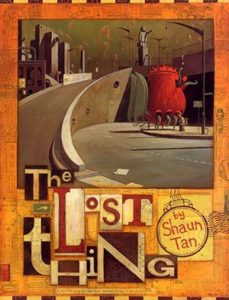
Look at the cover of the book, The Lost Thing. What do you see at first glance? Maybe you notice the book is/ is going to be a story set in a city – not quite an ordinary city but a familiar, recognisable city nonetheless. You may also assume/recognise the lost thing is something rather strange or unusual. Is that large reddish thing with the tentacles the ‘thing’? What can it be? Or you might have a very different set of responses when you look at this cover.
Now, I thought we might try an experiment. It isn’t a competition and I don’t think it matters if you are coming to this book for the first time or already know it well. But I really would love to hear about what you see and how you interpret the words and images on the cover when you look more closely at it. [You might prefer to google Shaun Tan’s book to find a larger, clearer image of the cover than the one provided here.]
Take some time to explore this – jot down some of your thoughts and ideas, as few or many as you like, and post them to the blog (or to me if you’d rather and I’ll report them back anonymously) so we can all see what others see! You might like to ask a child to do the same thing or report on their thoughts.
If you haven’t come across Tan’s work before you might also look out for The Red Tree, a book that always pulls at my heartstrings, or The Arrival, a story of immigration told in a series of wordless images.





 “. We have also had some wonderful reviews – you can see them on Amazon and at Good Reads (you can ask questions about the book on this site as well) or look at them here. We are keen for more reviewers (only honest reviews) and if you, or someone you know, would like a review copy, please let me know.
“. We have also had some wonderful reviews – you can see them on Amazon and at Good Reads (you can ask questions about the book on this site as well) or look at them here. We are keen for more reviewers (only honest reviews) and if you, or someone you know, would like a review copy, please let me know.


 u have been hesitant about encouraging children to read graphic novels, it may be time to change your mind. On the Playful Learning website you can read about why graphic novels make great reading and learning
u have been hesitant about encouraging children to read graphic novels, it may be time to change your mind. On the Playful Learning website you can read about why graphic novels make great reading and learning experiences for children.The article
experiences for children.The article 
 Now with the help of illustrator, Janet Trotta, the story has evolved into a picture book. At first reading to my kindy group, the children were very taken with the last double page spread of the book (it was
Now with the help of illustrator, Janet Trotta, the story has evolved into a picture book. At first reading to my kindy group, the children were very taken with the last double page spread of the book (it was  entirely Janet’s idea to do the page this way – so I am grateful to her). They liked pointing out to me all the things in Harriet’s bedroom that they’d seen during the story.
entirely Janet’s idea to do the page this way – so I am grateful to her). They liked pointing out to me all the things in Harriet’s bedroom that they’d seen during the story.





 If your parents said you were going to live on a desert island or in space and you could only take one book, what would it be? Any reason for your choice?
If your parents said you were going to live on a desert island or in space and you could only take one book, what would it be? Any reason for your choice? Can you suggest a book or an author for other children around your age to read?
Can you suggest a book or an author for other children around your age to read?



 The printed title. Letters of uneven sizes and in a mixture of upper and lower case with the almost childish printing of the author’s name give the title a friendly, unconventional feeling. The word Lost stands out a bit because of its rich deep reddish colour. This suggests lostness is likely to be the focus of the story.
The printed title. Letters of uneven sizes and in a mixture of upper and lower case with the almost childish printing of the author’s name give the title a friendly, unconventional feeling. The word Lost stands out a bit because of its rich deep reddish colour. This suggests lostness is likely to be the focus of the story.
 I Spy with my little Eye by Edward Gibbs. This book gives children the chance to guess which animal is on the other side of the spyglass. They get a hint because they can see part of it. It doesn’t seem to matter when they know the answers – they just love the repetition and the chance to call out the answer again and again. A good little twist in the ending as well.
I Spy with my little Eye by Edward Gibbs. This book gives children the chance to guess which animal is on the other side of the spyglass. They get a hint because they can see part of it. It doesn’t seem to matter when they know the answers – they just love the repetition and the chance to call out the answer again and again. A good little twist in the ending as well.
 Jeannie Baker’s Circle, for example, is about the wonder of the bartailed godwit’s journey from Alaska to Australia and New Zealand – the longest unbroken migration of any bird. Baker visited many of the locations along the way such as Alaska and China to select fabric, sand, vegetation and other unique materials to use in her beautiful mixed media collages. The book gently, yet compellingly, demonstrates how treatment of our own environment has far reaching effects on the lives of other living things both near and far.
Jeannie Baker’s Circle, for example, is about the wonder of the bartailed godwit’s journey from Alaska to Australia and New Zealand – the longest unbroken migration of any bird. Baker visited many of the locations along the way such as Alaska and China to select fabric, sand, vegetation and other unique materials to use in her beautiful mixed media collages. The book gently, yet compellingly, demonstrates how treatment of our own environment has far reaching effects on the lives of other living things both near and far.
Recent Comments